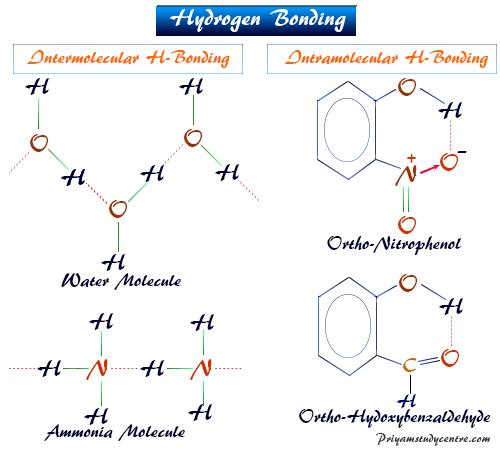

Note: You will find more discussion on the effect of hydrogen bonding on the properties of water in the page on molecular structures. This is why the boiling point of water is higher than that of ammonia or hydrogen fluoride. There are exactly the right numbers of δ+ hydrogens and lone pairs so that every one of them can be involved in hydrogen bonding. Notice that each water molecule can potentially form four hydrogen bonds with surrounding water molecules. Water as a "perfect" example of hydrogen bonding If you liken the covalent bond between the oxygen and hydrogen to a stable marriage, the hydrogen bond has "just good friends" status.

Hydrogen bonds have about a tenth of the strength of an average covalent bond, and are being constantly broken and reformed in liquid water. It doesn't go that far, but the attraction is significantly stronger than an ordinary dipole-dipole interaction. The δ+ hydrogen is so strongly attracted to the lone pair that it is almost as if you were beginning to form a co-ordinate (dative covalent) bond.

Note: If you aren't happy about electronegativity, you should follow this link before you go on.Ĭonsider two water molecules coming close together. Lone pairs at higher levels are more diffuse and not so attractive to positive things. Lone pairs at the 2-level have the electrons contained in a relatively small volume of space which therefore has a high density of negative charge. The hydrogen is attached directly to one of the most electronegative elements, causing the hydrogen to acquire a significant amount of positive charge.Įach of the elements to which the hydrogen is attached is not only significantly negative, but also has at least one "active" lone pair. Dotted bonds are going back into the screen or paper away from you, and wedge-shaped ones are coming out towards you. Note: The solid line represents a bond in the plane of the screen or paper. The molecules which have this extra bonding are:

These relatively powerful intermolecular forces are described as hydrogen bonds. In the cases of NH 3, H 2O and HF there must be some additional intermolecular forces of attraction, requiring significantly more heat energy to break. If you repeat this exercise with the compounds of the elements in Groups 5, 6 and 7 with hydrogen, something odd happens.Īlthough for the most part the trend is exactly the same as in group 4 (for exactly the same reasons), the boiling point of the compound of hydrogen with the first element in each group is abnormally high. Note: If you aren't sure about van der Waals dispersion forces, it would pay you to follow this link before you go on. The increase in boiling point happens because the molecules are getting larger with more electrons, and so van der Waals dispersion forces become greater. If you plot the boiling points of the compounds of the Group 4 elements with hydrogen, you find that the boiling points increase as you go down the group. Many elements form compounds with hydrogen. If you are also interested in the other intermolecular forces (van der Waals dispersion forces and dipole-dipole interactions), there is a link at the bottom of the page. Sodium chloride (NaCl), also known as table salt, is an example of a polar molecule.This page explains the origin of hydrogen bonding - a relatively strong form of intermolecular attraction.


 0 kommentar(er)
0 kommentar(er)
